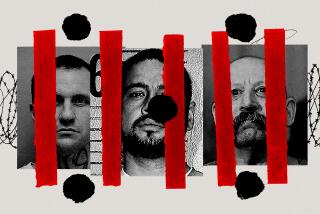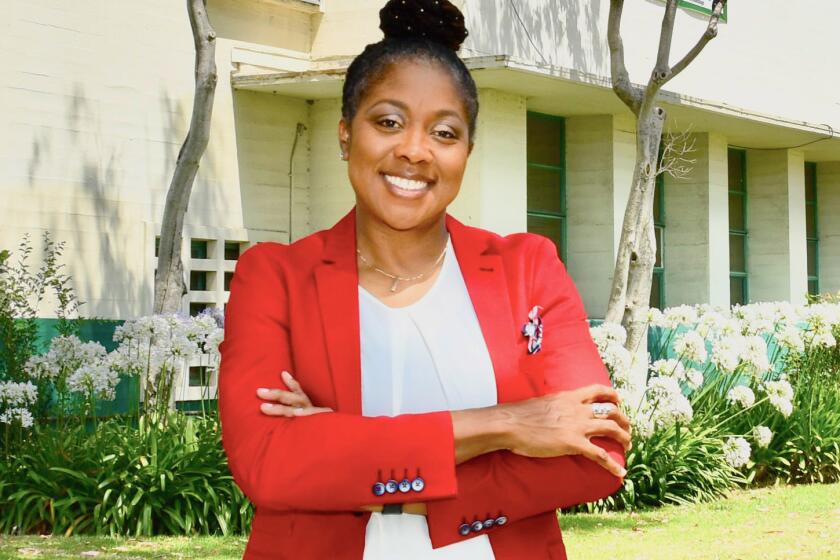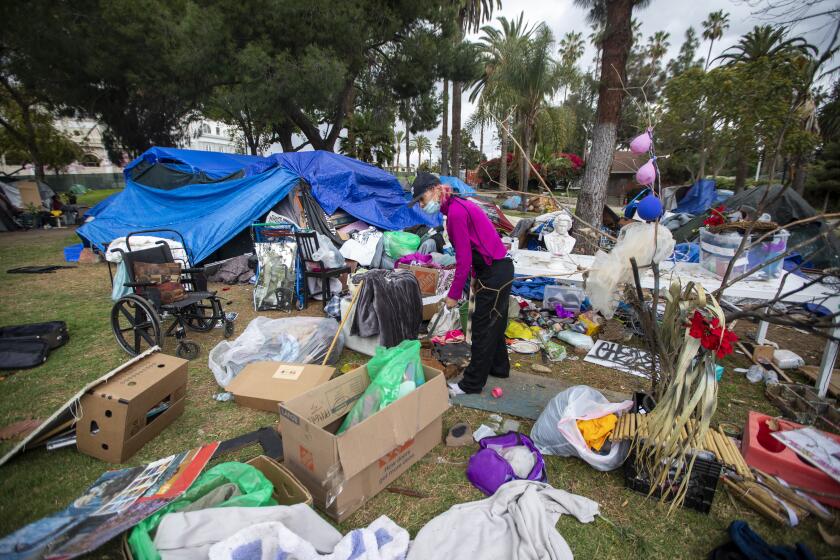4 Latino Gang Members Are Convicted of Anti-Black Plot
Four members of a Latino gang in Highland Park were found guilty Tuesday of unleashing a barrage of assaults and killings to push African Americans out of the predominantly Latino community in northeast Los Angeles.
The verdicts in a downtown federal courtroom marked the first time a street gang had been convicted of breaking federal hate crime laws, traditionally employed against white supremacist groups like skinheads and the Ku Klux Klan.
“I’m glad the truth is out,” said Luisa Prudhomme, whose 21-year-old son, Anthony, was killed when Avenues members allegedly kicked open his door and shot him in the head as he lay on a futon.
“This wasn’t just regular gang activity as usual,” she said. “This was hate crime. They promoted hatred and racism and ignorance.”
The four defendants -- Gilbert “Lucky” Saldana, 27; Alejandro “Bird” Martinez, 28; Fernando “Sneaky” Cazares, 25; and Porfirio “Dreamer” Avila, 31 -- face life in prison without the possibility of parole for their roles in the conspiracy. Sentencing for the first three was set for Oct. 23; for Avila, the date is Nov. 20.
Defense attorneys did not return calls for comment Tuesday, but one of them said in a previous conversation that there were numerous grounds for appeal.
From the start, the defense argued that prosecutors Alex Bustamante and Bobbi Bernstein had stretched civil rights statutes and Reconstruction-era anti-slavery laws way beyond their intended purposes to bring the case under federal jurisdiction. The judge denied their motions to dismiss the indictment on this basis, but the arguments will surely come up again in appeals court.
The Avenues date back to the 1950s and get their name from the numbered avenues that traverse the hills and ravines of Highland Park. The defendants on trial were part of the Tiny Locos, younger members of a clique called Avenues 43.
The compendium of crimes laid out against the gang members blended the most chilling aspects of old-time Deep South bigotry with a modern interracial rancor that has developed -- to some extent -- in struggling pockets of urban Los Angeles.
But unlike other racial gang strife in the city, the Avenues’ violence was deliberately aimed at African Americans with no gang affiliations, including women and children. The gang scrawled threats and racial epithets in graffiti on walls.
Among crimes committed by the defendants from 1995 to 2001, according to testimony, were shooting a 15-year-old boy riding a bike; hitting a jogger in the head with a pistol; drawing outlines of human bodies in chalk on a family’s driveway, along with a racial slur; and knocking a woman off her bike, threatening her husband with a box cutter, and saying, “You niggers have been here long enough.”
One night in April 1999, the defendants were riding in a van and came upon a black man, Kenneth Wilson, parking his Cadillac. When Martinez asked if anyone wanted to kill a black man, three of them jumped out, ran up to Wilson’s windows and opened fire, witnesses said. A shot to the head killed him before the car had even rolled to a stop.
Saldana bragged later that he just wanted to test out his new 9-millimeter Ruger.
Another black man, Christopher Bowser, was harassed and beaten up by the defendants for years. In December 2000, he filed a police report saying Martinez had assaulted and robbed him at a bus stop near his house. A week later, Bowser was shot to death at the same bus stop on Figueroa Street.
Five days later, Avila told a fellow gang member, in a taped phone call from jail, that he and Martinez had been beating up mayates for weeks, using a Spanish-language epithet for blacks. After mentioning Bowser, he added, “That fool is gone.” Avila was convicted in state court of the murder.
Throughout the nearly monthlong trial, defense attorneys tried to discredit the prosecutors’ key witnesses -- two imprisoned members of the Avenues who testified against their brethren -- as well as two police officers who took the case to the FBI and U.S. attorney. The lawyers introduced black witnesses who said they had never had any problems in Highland Park.
And in a bid to show there was no gang policy of racism, they brought in two black women -- the girlfriend of defendant Saldana when he lived in Arizona and the wife of an Avenues member who had nothing to do with the conspiracy and only vaguely knew the defendants.
As evidenced by the verdict, the jury did not buy the defense’s line.
The defendants sat casually throughout the testimony, wearing shirts, ties, sweaters and reading glasses, hair neatly combed.
But prosecutors tarnished their junior executive image by displaying photos showing their hidden tattoos on a screen directly above their heads. Jurors studied the large chest tattoos of the gang’s logo -- a bullet-pierced skull wearing a fedora and a fur collar. More damaging: the slogan “43 Kills for Thrills” etched on Martinez’s shaved head.
In her closing argument, Bernstein, a deputy chief in the civil rights division of the Justice Department, painted a picture of inhuman brutality, sometimes killing on a whim.
“These defendants and their co-conspirators riddled [Kenneth Wilson’s] car with bullets and shot him through the carotid artery, and they sped away and left him to bleed to death in front of his nephew because he was black and he dared to park his car on their street,” she said.
“These defendants and their co-conspirators tortured Christopher Bowser. They beat him and harassed him and chased him, and they warned him and threatened him and shot him in the face,” Bernstein said.
“They left that man to die in the street like a dog because he was black and dared to live on Avenue 44.
“That’s what this case is about.”
The defense claimed that police had concocted the conspiracy by linking a bunch of random attacks -- thus inflating common gang violence into a conspiracy against civil rights.
“This indictment was meant to grab headlines,” said Manuel Araujo, representing Saldana, in his closing arguments. “It was based on a fiction.”
The jury deliberated for two days.
Joe R. Hicks, vice president of the Los Angeles civil rights group Community Advocates, said the Highland Park racial violence was unique in the city. He said there have been deadly turf wars between black and Latino gangs in Venice and in the Harbor Gateway neighborhood, but never such violence targeting innocent people solely because of their race.
However, what happened in Highland Park stems from a broader racial tension in the city, he said. In some parts of Los Angeles, blacks feel Latinos are taking over their neighborhoods, displacing them to “the bottom of the market.” Latinos, particularly immigrants, sometimes harbor anti-black prejudice that they or their parents carried over the border, he said. And these notions harden in high school, where racial fights are not uncommon, and become truly ominous in prison.
The old dynamic of a powerful white majority oppressing a black minority is way too simple, and increasingly obscure, these days, he said.
“You step back and ask: Can black folks be bigots? Can Latinos be bigots? It’s clear that these gang members had an animus against blacks, Hicks said. “With the diversity of today’s world, we have to look at racism in a more encompassing way.”
The case started with LAPD officers who hit some obstacles in state court. They took their evidence to FBI agent Jerry Fradella and Assistant U.S. Atty. Thomas P. O’Brien, who brought in Bernstein to help them make the civil rights case.
In court papers, prosecutors said they had a witness who would testify that the Mexican Mafia, which controls many local Latino gangs, ordered the Avenues to carry out the attacks on African Americans. But the defense was ready to rip into that witness’ credibility; ultimately, the government never brought him to the stand.
The question now is whether federal law enforcement has gained a powerful tool against gangs, particularly ones doing the bidding of race-based prison gangs.
O’Brien, who is now chief of the criminal division in Los Angeles, compared the civil rights laws with laws on narcotics, guns and racketeering that also help them prosecute gang members in the federal realm.
He said his office is looking at other cases “where gang members are assailing individuals due to their race.”
More to Read
Sign up for Essential California
The most important California stories and recommendations in your inbox every morning.
You may occasionally receive promotional content from the Los Angeles Times.











